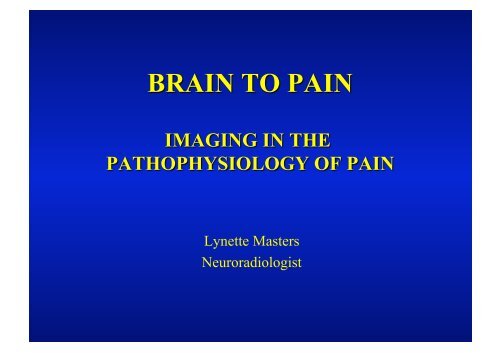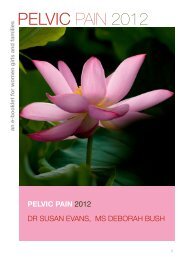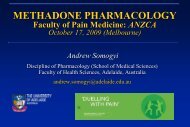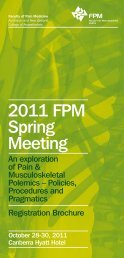Lynette Masters Neuroradiologist
Lynette Masters Neuroradiologist
Lynette Masters Neuroradiologist
- No tags were found...
Create successful ePaper yourself
Turn your PDF publications into a flip-book with our unique Google optimized e-Paper software.
<strong>Lynette</strong> <strong>Masters</strong><strong>Neuroradiologist</strong>
• Sensory-discriminative: the ability tolocalise pain and its intensity• Affective-emotional: the response to paini.e. its unpleasantness, fear and distress• Cognitive-evaluative: the interpretation ofpain, memory and anticipation of the eventand its recurrence
• Lateral pain system(sensory-discriminative)– primary & secondarysomatosensory cortex– thalami– insula• Medial pain system(affective-emotional)– prefrontal & posterior parietalcortex– anterior cingulate cortex• Extension/recruitment maybe linked to intensity
Schematic of cortical areas involved with pain processing. The highlighted areas summarize areas found active inprevious functional imaging studies. Colour-coding reflects the hypothesized role of each area in processing thedifferent psychological dimensions of pain. Numbers in parentheses indicate the relative involvement of these areasduring different temporal stages of the pain experience. Areas displayed include insula, anterior cingulate cortex(ACC), posterior cingulate cortex (PCC), primary somatosensory cortex (SI), secondary somatosensory cortex (SII),inferior parietal lobe (Inf. Par), dorsolateral prefrontal cortex (DLPFC), pre-motor cortex (Pre-Mot), orbitofrontalcortex (OFC), medial prefrontal cortex (Med. PFC), posterior insula (P. Ins), anterior insula (A. Ins), hippocampus(Hip), entorhinal cortex (Ento).Borsook et al, Molecular Pain, 2007
• High resolutionstructural imagingand tissuecharacterisation• Grey & white mattersegmentation, &volumetrics
Regional gray matter density decreases in CBP subjects. A nonparametric comparison of voxel-basedmorphometry between CBP and control subjects is shown. A, Gray matter density is bilaterally reducedin the DLPFC. The result is from a VBM permutation-based pseudo-t test and voxel-level contrasts whenall brain gray matter voxels were compared between controls and CBP subjects. Pseudocolour highlypositive values indicate regions where gray matter density was reduced in CBP subjects (controlsCBP).B, A nonparametric comparison spatially limited to the thalami revealed a significant decrease in graymatter density in the right anterior thalamus. A slice at the peak of decreased thalamic gray matter isshown. Pseudo-t values are colour coded; range is 3– 6.Apkarian et al, J Neurosci, 2004
• Functional MRI (fMRI)• Diffusion tensor imaging (DTI) => fibretracking• Perfusion imaging• MR spectroscopy (MRS)
WHAT IS fMRI?• a real time method of brain imaging• neuronal activity is NOT directly observedbut rather the effects of local increases inblood flow and changes in microvascularoxygenation, and more importantlydeoxyHb levels.• these haemodynamic responses producesmall changes in tissue contrast
“BOLD” IMAGING• Microvascular MR signal is stronglyinfluenced by the oxygenation state of Hb• deoxyHb (paramagnetic) tends to reduce thelocal MR signal by creating microscopicfield gradients• changes in oxygen saturation produce the“blood oxygenation level dependent-BOLD ” effect
“BOLD” IMAGING• increased neural activity stimulates a local increase inCBF and metabolic rate.• however, the rise in CBF is much higher than the rise inCMRO² (metabolic rate)• so, the oxygen extraction fraction falls• and there is a higher concentration of oxygenated blood(and concomitant decrease in deoxyHb) in the capillariesand veins• this leads to a slight increase in local MR signal• 70% of the blood lies within the capillary network andvenules. Therefore the signal changes detected in fMRI arethought to predominantly reflect regional deoxygenationstate of the venous system
“BOLD” IMAGINGRESTACTIVATION100% Oxygen100% Oxygen55% Oxygen70% Oxygen
“BOLD” IMAGINGfiringneuronCMRO25%YMR SIGNALΔχ4%susceptibilitydifferenceflow50%Oxygenationlevel60%⇒75%
Right hand tapping
Left hand tapping
• Hemodynamic– Response time of brain activity to the given stimulusand/or cessation of activation• Duration of Activation– Stimulated pain response can linger– Subtle activation needs longer duration periods• Emotional response– Subject response window• applicable for fMRI where choices are presented
PAIN INVESTIGATIONS• Processing of pain– Induced sensory stimulation• Heat• Subcutaneous superficial and deep injections– Chronic pain pre and post therapeuticinterventions• Comparison of stimulation of the painful limbversus non painful limb– Phantom pain in amputees– Does emotional pain cause physical pain?
PAIN INVESTIGATIONS• Pain Relief– Opiates and other drug treatments ortherapeutic measures– Altering pain perception with hypnosis, virtualreality and vibrations– Acupuncture and or acupressure• Studies beginning to appear on comparingfMRI to current PET results
• Acute pain– Rest period 30-60 sec– Induce pain & image continuously for 3-5minutes until pain recedes• Evaluation of painful stimulus• Quality, quantity, duration, extent– Delay period for recovery• Anatomical imaging– 2 nd induced stimulus
• Chronic Pain– Difficult because there is no “ off” or “rest”period– Done by comparing sensitivity of affected tounaffected limb or side
• PET demonstratesincreased rCBF inthe PFC and insula,& decreased rCBFin the thalamus
• Intra & interhemispheric corticalreorganisation• in upper limb amputees there is corticalexpansion of the face into the hand area,with lip pursing producing PLP• imagined phantom limb movementproduces bilateral somatosensory & motoractivation, and activation in the lip area.
HipTrunkArmHandFootFaceTongueLarynx
MacIver et al, Brain, 2008
MacIver et al, Brain, 2008
Moulton et al, PLoS ONE, 2008
• Electric Stimulation of the ArmC7T1Data courtesy of: Academic Hospital Maastricht, Dept of Radiology
• PET measures cerebral blood flowfollowing injection of a radio-isotope• It can evaluate glucose metabolism inactivated tissue• And by tagging specific molecules can beused to evaluate receptor distribution & siteof action
• It’s expensive• Requires physical proximity to an isotopesource• Has poor temporal resolution• uses ionising radiation
• The majority of clinical brain studiesare currently conducted with protonMR spectroscopy.• Spectroscopy of 31 P, 13 C, and 19 F canalso be performed.
• 2 major metabolites in disease states– Lactate– Lipids• 5 major metabolites in normal brain– N-acetylaspartate (NAA)– Glutamate and Glutamine (Glx)– Creatine and phosphocreatine (Cr)– Choline containing compounds (Cho)– myo-Inositol (MI)
PEAK NAMING
• Studies showing pain-induced glutamaterelease in the anterior cingulate• MRS changes in the thalamus, anteriorcingulate and posterior frontal cortex inpatients with chronic low back pain
DIFFUSION TENSORIMAGING (DTI)• MRI can detect the random (thermal)motion of water molecules in the directionof an applied gradient= diffusion• diffusion in white matter is anisotropic iedirectionally dependent• the direction of maximal diffusivitycorresponds with white matter tractorientation
• The degree of anisotropy and local fibreorientation can be mapped voxel by voxel• fractional anisotropy (FA) ranges from 0(isotropic) to 1 (maximal anisotropy)• the direction of maximal diffusivity can bemapped, with colour brightness modulatedby the FA
COMBINED FA & DIRECTIONALMAPS• colour indicates the preferred diffusion direction• brightness is proportional to the FAF-HL-RA-P
WHITE MATTER FIBRE TRACTS• ASSOCIATION FIBRES– interconnect cortical areas in each hemisphere– eg cingulum, superior & inferior longitudinal fasciculus• PROJECTION FIBRES– interconnect cortical areas with deep nuclei, brain stem,cerebellum and spinal cord– efferent and afferent– eg corticospinal and corticobulbar tracts and optic radiation• COMMISURAL FIBRES– interconnect similar cortical areas between hemispheres– eg corpus callosum, anterior commisure
cingulumcorpus callosum corticospinal tractsuperiorlongitudinalfasculusinferiorlongtudinalfasculusuncinate fasculusanterior optic radiationthalamic radiation inferior occipitofrontalfasculus
Comparison with anatomicalpreparation
• Tailored diagnosis +/- evaluation of pain• Drug efficacy in responders & nonresponders• Efficacy of new drugsBorsook et al, Molecular Imaging, 2006
















